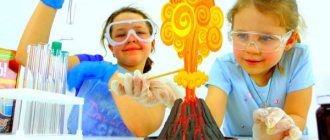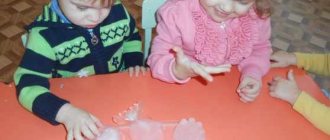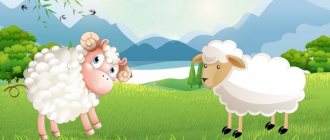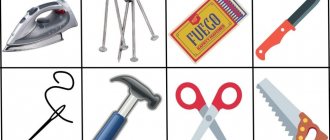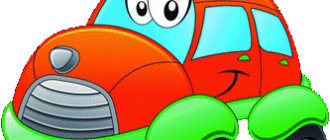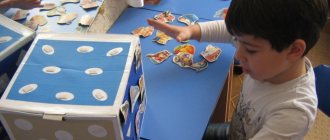Card index of experiences and experiments for children of senior preschool age
CARD FILE OF EXPERIMENTS AND EXPERIMENTS FOR SENIOR PRESCHOOL AGE.
The main requirements of preschool education in accordance with the Federal State Educational Standard for Preschool Education is the formation of the child’s cognitive interests and cognitive actions in various types of activities. Among the means of developing the cognitive and research activities of preschoolers, children's experimentation, aimed at satisfying the child's need for new impressions, deserves special attention, which is the basis for the emergence of activities aimed at understanding the world around us.
Developing as a cognitive and research activity aimed at knowing the qualities and properties of objects in the surrounding reality, their transformation, children's experimentation helps broaden their horizons, enrich the experience of independent activity, awaken curiosity, children learn to think, analyze, draw conclusions, and is an urgent problem of modern preschool education and education. During experimentation, situations are created that the child resolves through experiments and, by analyzing, draws a conclusion, independently mastering ideas about a particular physical law or phenomenon.
I present to you a card index of experiences and experiments for senior preschool age, which you can use in your teaching activities.
TO
art library of experiences and experiments
Topic: “Magic Magnet”.
Handout
: magnets; objects made of different materials - metal, rubber, wood, plastic, paper; paper clips.
Preliminary work.
Conversations about materials and their properties.
STROKE:
I show the children a magnet.
Educator:
Here in front of you is an ordinary magnet,
He keeps many secrets within himself.
- If a magnet is so strong and attracts objects made of iron, then maybe it should attract other objects as well? To test this, let's experiment. (Children pass and sit at tables)
The important thing is experimentation! Every moment of it is interesting to us.
Each child has a set of objects made of iron, wood, plastic, paper and glass.
— Take a magnet and determine for yourself which objects are attracted and which are not. (Divide into two groups, put in one plate those objects that are attracted to the magnet, and in the other - not). Children draw conclusions about which objects are attracted by a magnet and which are not.
— Zhenya, tell me, what objects are attracted to a magnet? What are they made of? So what are they like? (metal). - Anya, what objects are not attracted to a magnet? — The plastic spoon was not attracted to the magnet, the eraser was not attracted, the wooden cube was not attracted, and the paper toy was not attracted either. This means that a magnet only attracts metal objects.
Each child is given a piece of paper with a picture of various objects around a magnet: a needle, a paper clip, a cone, a button, a cup, a spool of thread, etc. The child must draw an arrow from the magnet to the object that it attracts. (Let’s clarify what happened).
I show the children wind-up toys, a duckling and a frog, but I can’t start them, because... the key accidentally falls into a bowl of water. Condition: the toys will be started by the one who can get the key without getting their hands wet. The water cannot be drained, because there will be no place for the duckling and the frog to plop down (we take out the key using a magnet) - we repeat the experiment twice.
Recall with your children the fairy tale “Cinderella”, where the evil stepmother mixed lentils with peas and forced Cinderella to sort them out. Who helped her? (Birds). And now the evil stepmother mixed the buckwheat with screws, bolts and nuts and again forced Cinderella to sort it out, the birds cannot help this time, they are afraid of breaking their beaks. - Maybe we can help? How can I do this faster? (Using magnets). All children take magnets and choose screws and nuts. (They stand around the steel on which there is a tray with cereal). The children sit at the tables.
Educator:
-I am a sorceress and can move objects without touching them with my hands.
I move a magnet under the table and the key moves. And I move the other one from above, above the key. If the children guessed it, I suggest they do the same with other metal objects.
We conclude: neither water, nor wood, nor plastic, nor other obstacles interfere with the magnet. - Do you want to be wizards? (I show how you can make a long chain of 4-5 pieces from paper clips). The magnet attracts a paper clip to this paper clip - another paper clip, etc. They're holding on for now. I propose to compete to see who can make the longest chain.
OOD – experience in the senior group.
Topic: "Snow and Ice."
Target
: introduce children to the physical properties of ice and snow; teach children to solve cognitive problems and draw conclusions; activate the dictionary by entering words: snowfall, thaw.
Equipment:
two glasses: with ice and with snow, pictures depicting snow and ice, pictures depicting winter fun.
STROKE:
Educator:
-Today we will conduct experiments and find out how snow and ice are similar to each other and how they differ.
Experience No. 1
. "Color determination".
What color is the snow? (white) What color is the ice? (colorless). If children name white, blue, gray, then you need to show them these colors for comparison.
Experience No. 2
. "Defining Transparency."
The teacher places a piece of ice and a lump of snow on the color picture. Offers to compare where the picture is visible and where it is not. The children conclude: you can’t see under the snow, but you can see under the ice. This means that the ice is transparent, but the snow is not. A minute of rest: children imitate the movements of skiing, playing snowballs.
Experience No. 3
. "Impact of Temperature".
Let's look at the snow and ice that were in the cups. What happened to them while we were playing? (They melted) correctly, under the influence of heat the snow and ice turned into water. This means that snow and ice are formed from water under the influence of frost. Conclusion: Let's now put everything we've learned together. Snow is white, opaque, loose, free-flowing, and turns into water under the influence of heat. Ice is colorless, transparent, fragile, and turns into water under the influence of heat. What do snow and ice have in common? Snow and ice are formed from water under the influence of frost. Well done, our experiment has come to an end. During the walk, the children explore the snow and ice once again.
Section "PHYSICS"
Experience. "Cold boiling water."
Target:
make water boil with one touch. Material: handkerchief, clean glass with smooth walls, pharmaceutical rubber band.
Progress:
Actions are performed together with children.
- Moisten a handkerchief with water and squeeze;
- fill the glass to the top with water;
- cover the glass with a scarf and secure with an elastic band, wrapping it around the glass;
- press the scarf in the middle with your finger so that its middle dips 2-3 cm into the water;
- lift the glass and, holding it by the bottom, turn it upside down;
- take the glass with your other hand under the hanging scarf and hold the glass.
Here one hand will support the scarf, and the free end will fall onto the hand. Use your free hand to push down the bottom of the glass.
Result:
water does not pour out of the glass. It seems that she is boiling. Conclusion: water does not seep through the scarf because the small voids in the fabric are already filled with water. We push the glass down. The fabric sags outward. Because of this, a vacuum is formed in the glass, air is pushed through the scarf. Air bubbles form in the water, causing it to appear to be boiling.
Experience. “Drowning or not drowning?”
Target:
demonstrate that salt water is denser than fresh water.
Material:
salt, two transparent glasses, two eggs, spoon, water.
Progress:
- pour water into a glass and lower the egg into it using a spoon;
Result:
the egg sinks.
- pour water into another glass and add 4 tablespoons of salt, stir until completely dissolved;
- Place the egg in this glass.
Bottom line
: The egg does not sink, but floats. Why? In fresh water, the egg sinks because... it is denser than water. An egg floats in salt water because... Salt water is denser than an egg due to its salt content.
Conclusion:
The density of salt water is greater than that of fresh water.
Experience. "Ice is solid water."
Target:
introduce children to the two states of aggregation of water - liquid and solid.
Material:
ice cubes of different sizes (large and small), two transparent cups for each child.
Progress:
- Place a large piece of ice in one glass and a small piece of ice in the other. Children should monitor the condition of the ice cubes in a warm room. Pay attention to how the ice cubes gradually decrease. What's happening to them? Which cube will melt faster?
It is important that children pay attention to the fact that different sized pieces of ice will melt over different periods of time. Result: water appeared in each glass.
Conclusion
: ice is also water, but in a solid state.
Experience. "Air".
Target:
demonstrate that air takes up space. Material: wide-neck jar, glass.
Move
:
- Turn the glass upside down and slowly lower it into a jar of water. The glass must be held straight. Will water get into the glass? Result: no water gets into the glass. Conclusion: there is air in the glass, it does not let water in.
"Air has weight" experiment.
Target
: show that air has weight.
Material:
scales, two balloons. Progress: - place one inflated balloon and one uninflated one on the scales. Result: the bowl with the inflated balloon will outweigh.
Conclusion:
air has weight.
Experiment “Air expands when heated.”
Target:
prove that air expands when heated.
Material:
plastic bottle, ball, bowl of hot water.
Progress:
- place the plastic bottle in the refrigerator for several hours;
- when it has cooled, put an uninflated balloon on the neck;
- then place the bottle in a bowl of hot water.
Result:
the balloon will begin to inflate on its own. - Now put the bottle in the refrigerator again.
Result:
the ball will go down. Conclusion: air expands when heated, and contracts when cooled.
"Magic Mitten" experiment.
Target:
find out the ability of a magnet to attract certain objects.
Material:
magnet, small objects made of different materials, a mitten with a sewn-in magnet.
Move
:
— demonstrate to children a trick: metal objects do not fall out of the mitten when you unclench your hand.
- invite children to take objects from other materials (wood, glass, fabric, paper)
– the mitten ceases to be magical.
- children examine the mitten, find a magnet, and try to use it.
Conclusion
: The magnet only attracts metal objects.
Experience "Magnetism".
Target
: identify the passage of magnetic forces through water and glass.
Material
: magnet, glass vessel, water, paper clip.
Progress:
- throw a paper clip into a jug of water;
— place the magnet against the jug at the level of the paperclip and slowly move it upward along the wall of the jug.
Result:
The paperclip follows the magnet and rises up.
Conclusion:
magnetic force passes through glass and water.
Experience “How to see “lightning”?
Target:
find out that a thunderstorm is a manifestation of electricity in nature.
Material:
pieces of woolen fabric, a balloon, a megaphone.
Move
:
- children rub pieces of fabric folded on top of each other with an inflated balloon;
- bring a megaphone to them (to amplify the sound) and slowly separate the fabric.
Result:
there was a crash.
Conclusion: when rubbing, the fabric became electrified, the appearance of a crackling sound is a manifestation of electricity.
Octopussy experience.
Target:
expand children's understanding of electrical charges.
Material:
a sheet of paper, scissors, a piece of fur.
Move
:
— cut the paper into 8 strips, not cutting 4-5 cm to the edge. Raise the octopus, folding the uncut side into a ring.
Result:
the legs hang down.
— on the table, rub the octopus with a piece of fur, running the fur along the legs;
— lift the octopus, rolling the uncut side into a ring.
Bottom line
: legs spread out like a bell.
— put your free hand inside this bell.
Result:
tentacles grabbed my hand.
Conclusion:
from friction, equal electrical charges were formed on all legs. When the octopus was rolled up, the negatively charged tentacles pushed away from each other and spread out like a bell. When a hand with a positive charge was placed inside, the negatively charged tentacles were attracted to it.
Section "CHEMISTRY"
Experience “Transparent – opaque”.
Target
: recognize objects made of glass, determine its qualities and properties.
Material
: glass cups, colored water, stone.
Progress:
- pour colored water into a glass beaker; - lower a stone into it; Bottom line
: The stone is visible.
Conclusion
: glass cup – transparent.
Experience "Magic Coins".
Target:
recognize objects made of metal, determine its thermal conductivity property.
Material
: a few coins.
Progress:
- invite one child to squeeze one of the coins in his hand and, holding it a little, put it on the table next to the others.
- another child, having touched all the coins, must determine which one was held in his hand.
Result:
whichever one was the warmest was held in the hand.
Conclusion:
the metal heats up quickly and retains heat.
Section "ASTRONOMY".
Experience "Star Hours".
Target
: Find out why stars move across the night sky.
Material
: black umbrella, white chalk.
Progress:
- use chalk to draw the constellation Ursa Major on one part of the inside of the umbrella;
- raise the umbrella above your head;
- Rotate the umbrella slowly counterclockwise.
Result:
the center of the umbrella remains in one place, and the stars move around. Why? The stars in the constellation Ursa Major make apparent movements around one star - Polaris - like the hands on a clock. We see the rotation of the starry sky, but this only seems to us, since our Earth rotates, and not the stars around it.
Conclusion:
The Earth's axis of rotation is directed towards the North Star, and therefore the stars appear to revolve around it.
Experiment “Straight or in a circle?”
Target:
determine what keeps satellites in orbit.
Material:
paper plate, scissors, glass ball.
Progress:
- the adult proposes to solve the problem: what would happen to the satellite (the Moon) if the planet did not attract it.
- cut a paper plate in half and use one half;
- place a ball in it, place it on the table and tilt it slightly so that the ball quickly rolls along the notch in the plate.
Result:
the ball rolls off the plate and moves away from it.
Conclusion:
objects move in a straight line unless a force acts on them.
The Moon would also move away from the Earth in a straight line if Earth's gravity did not keep it in a circular orbit.
Review of the best experiment kits for children
When choosing a children's experiment set, try to take into account two important factors: the age and interests of the child - a teenager is unlikely to like a set with the simplest experiments for kids, and if a child dreams of a set for chemical experiments, it is worth buying just such a set. But there are no gender differences in the sets for young experimenters; the sets are equally suitable for both boys and girls.
"Spy Kit" (EUREKA)
The child will play detective and at the same time get acquainted with a magnifying glass, disappearing ink, and fingerprint powder.
Suitable age : 4-7 years.
Approximate price : 500 rubles.
"Experimentarium" (1 TOY)
A set with which a child can conduct 65 different experiments in the field of chemistry and physics. All experiments are quite simple, the kit is accompanied by colorful instructions.
Suitable age : 4-10 years.
Approximate price: 2000 rubles.
“Entertaining experiments for beginners” (RANOK CREATIVE)
The kit includes only safe components for conducting experiments in the field of physics, chemistry, biology - corn starch, food coloring, Petri dish and the like.
Suitable age : 5-10 years.
Approximate price: 1200 rubles.
"Molecular Cooking" (Qiddycome Super Professor)
A set with detailed recipes with which the child can prepare molecular gastronomy dishes, for example, marmalade pasta or a yogurt sandwich. The kit includes not only the products necessary for cooking, but also the necessary utensils: various containers, spoons, chopsticks.
Suitable age : 7-14 years old.
Approximate price: 2000 rubles.
"Experiments in a Box" (Simple Science)
The kit includes components for carrying out 14 fascinating physical and chemical experiments: for growing a crystal, creating polymer worms, making a hologram, and for other experiments.
Suitable age : 8-14 years.
Approximate price: 2700 rubles.
"Chemical laboratory" (BONDIBON)
A large set will certainly help your child fall in love with chemistry - the set includes safe reagents for 200 different chemical experiments and experiments.
Suitable age : 8-14 years.
Approximate price: 3000 rubles.
"Big Chemical Laboratory" (Intellectico)
The set includes components for 84 entertaining chemical experiments: the young chemist will learn how to make a volcano, create spy ink, coat a coin with silver, and many other interesting things.
Suitable age : 8-14 years.
Approximate price: 2500 rubles.
Even if it seems to you that you are as far from physics and chemistry as possible, still try to conduct at least the simplest experiments with your children. And perhaps, over time, both you and your child will truly love science!
